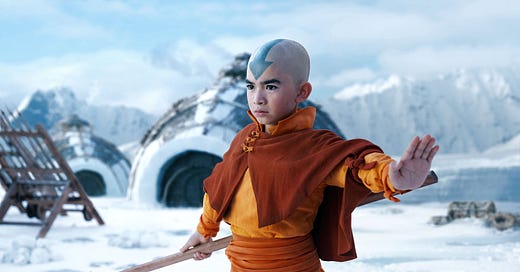Building A Bender In 5th Edition DnD
Ideas for Bender Characters In Dungeons and Dragons #avatarthelastairbender
Avatar The Last Airbender is out on Netflix and which means bending could make a come back in back in DND. Over the years I have seen some cobbled together character builds, but there are no true 1:1 bender classes for dnd 5e. In this issue I’ll offer some of the ideas I have seen and will throw in a few of my own ideas along the way.
This is an introduction, so, if you’re not subscribed to this newsletter, be sure to subscribe as I will be offering ideas for each elemental bender in the weeks to come.
Will they be perfect? No, but hopefully my tinkering around will inspire you to tinker, test and tweak to make the bender character you want to make and, of course, always check with your DM.
At the time of this post, I will be referring to the 2014 5th edition of Dungeons and Dragons. The new core books (5.5) will retain much of the 5th edition mechanics but some things will be changing such as schools of magic to magic colleges.
Let’s start with what dnd 5e does give us to work with, as far as elemental leanings, in the form of the two races, the Genasi and the Eladrin Elves. According to Monster of the Multiverse,
Genasi
“Air Genasi are descended from djinn, the genies of the Elemental Plane of Air.”
“Earth Genasi trace their ancestry to dao, the genies of the Elemental Plane of Earth, inheriting dao’s steadfast strength and control over earth.”
“Fire Genasi descended from efreet, the genies of the Elemental Plane of Fire, fire genasi channel the flamboyant and often destructive nature of flame.”
“Water genasi descend from marids, aquatic genies from the Elemental Plane of Water. Water genasi are perfectly suited to life underwater and carry the power of the waves inside themselves.”
Eladrin Elves
Eladrin are elves of the Feywild, also in Mordenkainen Presents: Monsters of the Multiverse, a realm of perilous beauty and boundless magic. There are fours seasons of elves.
Autumn could represent air bending
Winter could represent water/ice bending
Spring could represent an earth bending
Summer could represent a fire bending
Druid (Classes)
If you are looking for classes to base your bending through you can choose the Druid who has access to various environmental circles.
Circle of the Land
Arctic (could be combined with Coast)
Coast (water bending)
Desert (fire, air or earth bending)
Mountain (earth bending)
Circle of the Moon
“At 10th level, you can expend two uses of Wild Shape at the same time to transform into an air elemental, an earth elemental, a fire elemental, or a water elemental.”
Since the Water Benders in Avatar rely on the moon as the source of their water bending, you could use Circle of the Moon, which could apply to any water based land such as the coast, swamp or arctic, and use it to expand water bending abilities.
This druid circle allows for elemental wild shapes.
Circle of Wildfire
“These druids bond with a primal spirit that harbors both destructive and creative power, allowing the druids to create controlled flames that burn away one thing but give life to another.”
This druid has access to a number of flame and fire spells and, at second level, can summon a wildfire spirit.
Monk: Way of the Four Elements (Class/Discipline)
This is one of the Monk’s monastic traditions found in The Players Handbook.
“Monks make careful study of a magical energy that most monastic traditions call ki. This energy is an element of the magic that suffuses the multiverse — specifically, the element that flows through living bodies.”
In the monastic tradition, The Way of the Four Elements, the Monk must use Ki points to use a particular element (spell) or to increase the damage of that attack.
You could work with your DM on the section called Elemental Attunement, as to whether these could be your “cantrips”, showing your natural affinity for bending before choosing The Way of the Four Elements as your tradition.
You can use your action to briefly control elemental forces within 30 feet of you, causing one of the following effects of your choice:
Create a harmless, instantaneous sensory effect related to air, earth, fire, or water, such as a shower of sparks, a puff of wind, a spray of light mist, or a gentle rumbling of stone.
Instantaneously light or snuff out a candle, a torch, or a small campfire.
Chill or warm up to 1 pound of nonliving material for up to 1 hour.
Cause earth, fire, water, or mist that can fit within a 1-foot cube to shape itself into a crude form you designate for 1 minute.
Final Thoughts
This brief list of ideas are a starting point for any of you who want to give bending character creation a try. There are also 3rd party subclasses and classes you can purchase on the DM’s Guild such as
Monk Subclass: Way of the Bender
5e Elemental Bender’s Class Guide
Why work harder if you don’t have to.
You can check out my walk through of each of these on my channel
Whether it is classes or races, work with your DM or player to
determine what abilities you receive and when (what level)
Where your power comes from and what is the cost to use it (Ki Points, HD, HP, etc.)
talk about how to use your down time to visit a master bender to grow new abilities, etc.
Thanks for being a subscriber! I’d love it if you shared this newsletter with a friend who might be interested in building a bender for their game.
If you’re not a subscriber, I’d love to have you be a part
Have you built a bender for dnd? What resources did you use? Leave me a comment.



